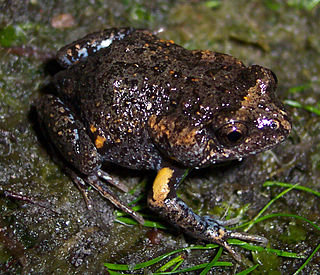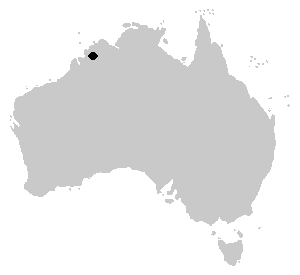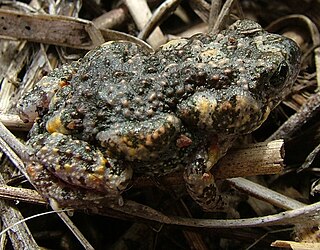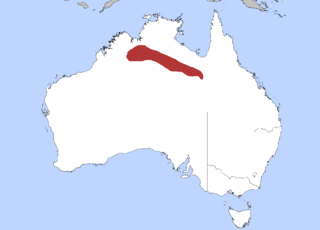
Egernia is a genus of skinks that occurs in Australia. These skinks are ecologically diverse omnivores that inhabit a wide range of habitats. However, in the loose delimitation the genus is not monophyletic but an evolutionary grade, as has long been suspected due to its lack of characteristic apomorphies.

The Kimberley is the northernmost of the nine regions of Western Australia. It is bordered on the west by the Indian Ocean, on the north by the Timor Sea, on the south by the Great Sandy and Tanami deserts in the region of the Pilbara, and on the east by the Northern Territory.

The night parrot is a small parrot endemic to the continent of Australia. It has also been known as porcupine parrot, nocturnal ground parakeet, midnight cockatoo, solitaire, spinifex parrot and night parakeet. It is one of the most elusive and mysterious birds in the world, with no confirmed sightings of the bird between 1912 and 1979, leading to speculation that it was extinct. Sightings since 1979 have been extremely rare and the bird's population size is unknown, though based on the paucity of records it is thought to number between 50 and 249 mature individuals, and it is classified by the IUCN as an endangered species.

Uperoleia is a genus of frogs in the family Myobatrachidae. They are native to northern and eastern Australia and southern lowlands of New Guinea. These are small squat frogs, more commonly known as "toadlets". They have glandular skin, often with a pair of raised glands behind each eye, or on the flanks.

The Bibron's toadlet or brown toadlet is a species of Australian ground-dwelling frog that, although having declined over much of its range, is widespread through most of New South Wales, Victoria, south-eastern Queensland, and eastern South Australia, including Kangaroo Island. Bibron's toadlet settles in a wide variety of habitats within these region but they mainly reside in dry forests, woodland, shrubland, grassland, coastal swamps, heathland, and sub-alpine areas. They deposit their eggs in leaf litters during the flooding season, which is essential for the proper development of the egg. This species has high sexual dimorphism within the species and utilizes chemosignals to attract potential mates.

The smooth toadlet is a species of Australian ground-dwelling frog native to the coast and west of the ranges of south-east Queensland, all of eastern New South Wales and north-eastern Victoria.

The dusky toadlet is a species of Australian ground-dwelling frog that inhabits coastal areas from just north of Sydney, New South Wales to mid-northern Queensland.

Tyler's toadlet is a species of ground frog that is found in coastal areas in southern New South Wales and eastern Victoria.

Uperoleia marmorata commonly known as the marbled toadlet, is only known by the holotype collected in the Kimberley region of Western Australia by Gray in 1841.

The wrinkled toadlet is a species of small, ground-dwelling frog in the family Myobatrachidae It is endemic to Australia. It is also commonly called the small-headed toadlet, red-groined toadlet or the chubby gungan.
The glandular toadlet is a species of frog in the family Myobatrachidae. It is endemic to the arid coast near the Pilbara in Western Australia. Its natural habitats are subtropical or tropical dry lowland grassland, rivers, intermittent rivers, swamps, intermittent freshwater marshes, and canals and ditches.
The mole toadlet is a species of frog in the family Myobatrachidae. It is endemic to Western Australia. Its natural habitats are dry savanna and subtropical or tropical dry lowland grassland.

The blacksoil toadlet is a species of frog in the family Myobatrachidae. It is endemic to Australia. Its natural habitats are subtropical or tropical dry lowland grassland, subtropical or tropical seasonally wet or flooded lowland grassland, and intermittent freshwater marshes.
Margaret Davies is an Australian herpetologist born on 8 November 1944. She worked at the University of Adelaide studying Australian frogs, retiring in 2002. Initially appointed to a teaching post at the university, she was inspired to research frog taxonomy and their ecology from the 1970s. She identified over 30 new species of frogs during her career. She has contributed to over 120 publications.

The Pilbara shrublands is a deserts and xeric shrublands ecoregion in Western Australia. It is coterminous with the Pilbara IBRA region. For other definitions and uses of "Pilbara region" see Pilbara.
The Howard Springs toadlet, also known as the Howard River toadlet, Davies's toadlet or the Darwin sandsheet frog, is a species of small frog that is endemic to Australia. The specific epithet daviesae honours Australian herpetologist Margaret M. Davies.
Mahony's toadlet is a species of small frog that is endemic to Australia. The specific epithet honours Professor Michael Mahony of the University of Newcastle for contributions to the study of Australian frogs.
The tiny toadlet is a species of small frog that is endemic to Australia. The specific epithet micra refers to its small size.
The ratcheting toadlet is a species of small frog that is endemic to Australia. The specific epithet stridera, as well as the common name, refer to the grating nature of the call.
Gurrumul's toadlet is a species of frog in the family Myobatrachidae. It is endemic to the Wessel Islands of the Northern Territory, Australia. It is only known from 3 specimens collected in 1993 and was found to be a distinct species via genetic analysis, and thus little is known about its diagnostic features from other Uperoleia species. It can be distinguished from the stonemason's toadlet by its rounded inguinal glands, but appears physically identical to the flood plain toadlet.









